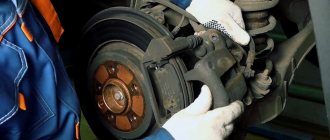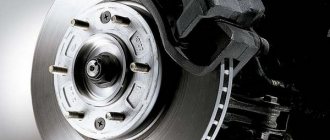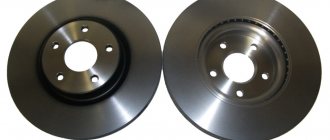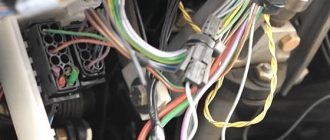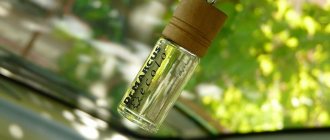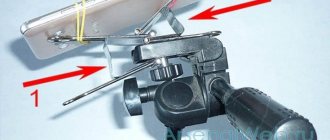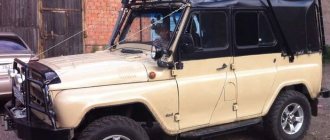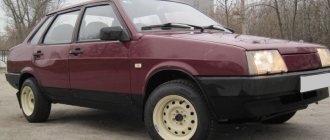The most important thing for ensuring safety when driving a car is, without a doubt, the braking system. And the condition of the working surface of the brake discs greatly affects the performance of the entire system. The average service life of a brake disc is about 70 thousand km. The car has a much longer service life. Therefore, the need to replace or repair these parts appears from time to time in the life of every car owner. In cases where the defects that arise are minor and are not associated with temperature deformation, excessive wear or cracking, turning the brake discs yourself without removing them is an inexpensive repair method.
When is a groove necessary?
Grooving, as well as their replacement, should be done only in pairs standing on the same axis. Otherwise, the difference in braking forces on the right and left will tend to turn the car.
Signs of need for grooving:
- Wave-shaped work surface.
- Scouring on the working surface.
- Excessively rapid wear of brake pads with the same driving style. On average, a set of brake pads lasts for 30 thousand km.
- The brake pedal shakes during braking.
What is a groove
Not all motorists know when it is possible to get by with regular grinding or grooving, and in what situations it is better to replace the brake pads or the discs themselves.
There are many reasons why grooves appear on the surfaces of brake discs, and so-called flanges are formed along the edges where the pad adjoins the disc. But I will not dwell on this issue in detail. If you want, I will write a separate article in which I will describe in detail the reasons for wear of the brake unit, the consequences and solutions to emerging problems. In the meantime, we will continue to study the current topic.
Grooving technology involves removing surface defects from the working surfaces of automobile brake discs.
Moreover, each disk has its own restrictions on the minimum layer of the working surface at which the unit maintains its efficiency. You can find out this indicator from the owner's manual if you have factory brakes, or from the description of the spare part that you installed on your car.
Several ways of grooving without removal
Whatever method of turning brake discs you choose, before you begin, make sure that their thickness is greater than the maximum permissible and that they are not cracked. If they are too thin or have cracks, don't risk repairing them. Better buy new ones. Grooving is the leveling of working surfaces using a cutter,
and the methods proposed below are grinding brake discs without removal.
- There are special units for grinding brake discs without removal. But I think you will agree with me that it is not worth buying a unit just to grind a couple of discs. It will be cheaper to completely update the brake system.
- If the disks are on the drive axle. You will need a flat wooden block measuring 30x15x5 cm and several sheets of sandpaper with coarse abrasive grain (for example, No. 40) on a fabric base. Using sandpaper and a block is preferable to using an abrasive wheel for sanding. Because the working surface of the abrasive wheel will soon cease to be flat after the start of grinding. And the plane of the sides of the block will not change during operation. Don't forget to change the sandpaper - this will speed up the sanding process and improve its results. Raise the car with a jack and put some kind of insurance under it. Remove the wheel, brake caliper and brake disc boot. Hang the caliper higher so it doesn't interfere. Start the engine, put the gear in gear, and adjust the rotation to your liking. Lay a sheet of sandpaper with the abrasive down, place a block on it with the wide side, and bend the edges of the sheet protruding from under the block upward. Press the resulting structure alternately with its wide edge against the working surfaces of the brake disc. Do not try to press it harder, it is better to move the point of contact all the time.
- Brake mechanisms located on a non-driving axle are ground without removal using the same device made from a block and a sheet of coarse sandpaper. Only it will not be the disk that will move, but the block with sandpaper. It will be moved by the strength of your hands. But to tell the truth, doing this without removing the disk is very inconvenient; things will go much faster if you remove them and put them on the workbench.
- Grinding brake discs on the go. This method is suitable for restoring disks located on both the drive and driven axles. But it is suitable for eliminating only minor defects. It will not be able to eliminate the result of severe temperature deformation. First, special devices should be made from old brake pads. To do this you need a grinder with a diamond cutting disc. And also an abrasive cleaning disc for it. It is necessary to cut two wedge-shaped segments from the grinding wheel. Make two recesses in the old brake pads in accordance with the shape of the wedge fragments. Their depth should be a few tenths of a millimeter less than the thickness of the abrasive inserts, so that the latter, after installation, rise above the surface of the pads.
Insert the sectors into the recesses, having previously lubricated them with some kind of glue so that they do not fall out. Install the resulting “abrasive pads” into the caliper instead of the standard ones. To sharpen working surfaces, you need to drive from 5 to 10 km, braking periodically. Plan your route to avoid sudden braking or slowing down on bumpy areas. During the trip, monitor the result of grinding. The bead formed around the perimeter of the disk can be removed after the end of the trip with an ordinary file with a large notch.
After leveling the working surfaces, it would not hurt to treat them with finer-grained sandpaper in order to reduce the depth of the marks. You should not immediately use fine-grain sandpaper, because it will make the surface less smooth and the surface will be smooth, but wavy.
Where to look for a fault
- The beating of the front discs is often reflected not only into the pedal, but also into the steering wheel.
- The rear beating is better felt through the vibrations on the body.
- The front mechanisms more often suffer from thermal deformation, since they bear the main load during braking, therefore, they heat up more. Deformation occurs as follows. When braking, the disc heats up and expands evenly. Water that gets onto a certain area quickly cools it, and as it cools, it shrinks and warps the entire part.
- The rear ones are more susceptible to corrosion. Since, due to their low load, water that gets on them does not dry out for a long time.
The car's brake system requires regular maintenance. In particular, this applies to replacing brake pads, inspecting discs for defects, replacing fluid, etc. But this is not always done on time or at all. Many people turn to service stations only in case of obvious malfunctions. But all this can be avoided if you change the pads in a timely manner and do not forget to sharpen the brake discs.
Brake disc boring machine and other work tools
Replacing brake discs with new ones is not a cheap pleasure, so in some cases you can restore them yourself. Let's look at how brake discs are bored without removal, and what is needed for this. However, before you start grinding directly, you need to find out whether it is necessary, or perhaps in this case the discs only need to be replaced.
For this purpose, we carry out a visual inspection and determine the extent of damage. The fact is that the manufacturer sets the minimum possible thickness of the brake discs; this value is usually indicated in the operating instructions . Therefore, if the grooves are too deep and the surface is severely deformed, then in this case we can only talk about replacement.
But, if the part is subject to restoration, then you should get the following tools: a jack, a hammer, a wrench (for removing a wheel), and you will also need a special machine for boring brake discs. The grooving technology consists of the following stages. First, you need to dismantle the wheel, at the next stage the brake pad is removed, and then you need to attach a special adapter to the car hub. The machine support for grooving is inserted into this adapter.
About car brake discs
Typically, manufacturers indicate the service life of a particular serviced unit. That is why it makes no sense to talk about specific numbers. On some cars the pads last 10-15 thousand kilometers, on others they last 50 or more. This also applies to disks. If they are of high quality, then they can easily last 100-150 thousand kilometers, provided that the entire system is in good working order. If the caliper guide jams and the pad does not move away from the disc, then it is quite logical that the entire assembly will heat up, and the discs and pads will not only be subject to increased wear, but may also fail due to overheating.
Sharpen or change?
Some people are in favor of sharpening brake discs, while others are only inclined to replace them. Here you need to look at the situation. If the disk is erased, then whether you sharpen it or not, it will no longer perform its function correctly. When the wear is insignificant, but during braking there is such an effect as beating in the steering wheel or brake pedal, then a groove is quite acceptable. And again, in the absence of mechanical defects in the form of cracks, etc.
That is why it is not possible to answer the question posed unambiguously. There are often reviews that the groove gives only a short-term effect and can only be saved by a full replacement paired with the pads. This is partly true, but not always. Let's take a closer look at how to properly sharpen brake discs. Today there is a lot of equipment and various technologies that allow this to be done not only quickly, but also efficiently.
Why do they change or sharpen?
In fact, you can ride these too! BUT it’s not just that you come to the service center and complain that when you press the brake pedal you have:
- The steering wheel hits so hard you can't just hold it
- There is a very strong vibration in the body
- By the way, many people also experience extraneous sounds in the suspension
It is worth noting that they actually last about two to three times when changing the brake linings, and then they need to be changed.
The thing is that with high mileage, the pads fill grooves on the surface of the disc, the sides become non-parallel, and pits and protrusions form. An edge forms on the top of the disc.
Also, temperature changes when you abruptly drive into a puddle can really lead to it, that is, as our common drivers say, “carobit.”
And now, when you press the brake pedal, the pads are pressed against the disc under the influence of the caliper pistons, and all these irregularities are transmitted to the steering wheel or even the suspension and body.
Well, what remains is either to install completely new ones, or to sharpen these old ones, and not much, but to a small size (more on this a little later).
Express grooving of brake discs without removal
As the name implies, in this case there is no need to dismantle the unit being repaired from the car. That is why such a groove is performed extremely quickly, and is not inferior in efficiency to a full-fledged repair on a lathe. Many modern service stations are equipped with such stands. To perform the work, you only need to remove the wheel. Next, a special unit is installed on the studs; its block is brought directly to the plane of the disk.
The grooving process itself takes approximately 10-15 minutes. Therefore, it will take no more than one hour to complete the work in a circle. Cutters for grooving brake discs on the machine block are installed on both sides. This allows you to significantly reduce runout during the operation. True, this method also has its disadvantages. The main disadvantage is the impossibility of turning discs with a braking element such as a handbrake.
Pros and cons of the procedure
Grooving brake discs is a procedure that has one obvious advantage - such a service is inexpensive. By buying high-quality spare parts and doing the work yourself, you can also save a lot.
But it is important to remember that turning discs is a temporary solution. Car service specialists do not recommend performing this procedure more than once on a set of discs. This is due to the fact that the thickness of the disc decreases during grinding. The smaller the thickness, the more fragile the disc becomes and, in addition, it heats up when braking.
You may also be interested in: The best rust converter for a car
The driver must monitor the brake discs of his car so that their wear does not exceed acceptable limits. To do this, it is recommended to check the groove with the caliper every 10-15 thousand kilometers, comparing the measured values with those recommended by the manufacturers.
About the cost of work
Much depends on the location of the repair and its method. In many car services you will see different price tags, but at the same time everyone will praise the quality of the work performed. It is worth noting that turning brake discs without removing them will cost a little less, since the craftsmen will not have to unscrew the extra nuts. Also, the cost of services varies depending on the class of car:
- domestic passenger car - 700 rubles per disc;
- foreign car - 1,000;
- business class foreign car - 1,100;
- SUVs - 1,200;
luxury cars (sports) - 1,500.
Recommendations for servicing the brake system
- Strictly observe the timing of inspections and preventive maintenance;
- Purchase original parts and their analogues according to the catalog numbers specified in the operating instructions;
- Avoid excessive wear of the friction lining and pads;
- Install new pads in pairs;
- Avoid getting into holes, bumps, potholes at medium and high speeds.
The cost of the disc pumping service is negotiated individually with the service station manager. A number of factors influence price formation:
- Degree of wear;
- Furrow depth;
- Presence of corrosion;
- Deformation, third-party mechanical damage.
In parallel with the restoration of the discs, inspect the friction linings, working cylinder, and pipes. If there are defects or cracks, replace the parts with new ones. It is unacceptable to use a technical device with a faulty brake system.
Once boring is complete, bleed the brake circuit. This is necessary to adjust the tightness of the pad to the disc body. Replace the fluid if sediment, cloudiness, or discoloration are visible. In cars produced after 2000, the brake circuit is filled with DOT-4 class fluid. The volume varies from 1.0 to 1.5 liters depending on the brand.
Machine for turning brake discs
The equipment used to carry out the work plays an important role. Today, many car service centers use portable stands that allow grooving without removing the disc. Nevertheless, stationary lathes have not yet been canceled. They are more functional, and if a professional works, then the result obtained is much better. The machine for turning brake discs allows you to work in three planes. That is, the sides where the pads are adjacent and the place where they press against the hub are machined. At the end you will have a perfectly flat disc, and you can forget about beating during braking like a bad dream.
The most popular machine today is PRO-CUT, costing approximately 200,000 rubles. It is considered professional and allows you to sharpen the disc without removing it from the hub. But if possible, it is better to change it, as a last resort - re-grooving the brake discs. The price of the service today is constantly increasing. In large cities it can reach 3,000 rubles with checking for runout, etc. However, this is a rather expensive procedure.
Groove without removal
Modern industry produces special equipment that allows you to grind brake discs without removing them, directly on the car. This approach is justified. After all, the wheel hub, which rotates on bearings, specifically provides the necessary conditions for precise machining of the part.
When boring brake discs, you will have to proceed in the following order:
- Place the car on a strong and rigid support.
- Remove the wheel.
- Remove the caliper and clean the disc from foreign contaminants, at the same time making sure that it rotates freely.
- A special adapter is installed on the hub and precisely centered, connecting the rest of the equipment to it.
- They turn on the machine and wait until it spins the epicenter at the required speed, making adjustments to the surface coating.
If you have special equipment, you can process brake discs without removing them in a short time.
Can I do it myself?
There is a corresponding section in the operating and repair manual for VAZ family cars. It clearly and clearly states that grooving can be done in a garage without special equipment. For example, you can remove a shoulder that has formed as a result of disc wear or the use of hard pads using a file. To do this you need to perform the following steps:
- jack up the car and remove the wheel;
- start the car and engage 4th or 5th gear;
- Using a file or a coarse-grained emery disc, the bead is removed first on one side and then on the other.
Of course, this is only relevant for the axis that is the drive. In addition, it is not recommended to do this on foreign cars; it is better to just take it and replace the disks with new ones. Where to sharpen brake discs? It is best to go to a proven service station, where you have already applied more than once. It is also advisable to first familiarize yourself with the cost of the work. Some services charge too much for grooving. Perhaps they do quality work there, although this is not a fact. Too cheap is also not good. It is likely that they neglect quality and deceive customers.
Self-growing options
Since the price of professional grooving services scares many, some motorists are thinking about carrying out such a procedure on their own.
I strongly advise against taking on such work unless you have the skills, experience and special equipment. Such grinding will definitely not get rid of the disc runout, and will serve as a temporary measure. Often in video instructions, as well as in descriptions of self-growing published on the same Drive website, a grinder, grinding wheels, sandpaper and other available abrasives are used.
The effect is insignificant and only restores the surface of the brake disc for a while. Therefore, it is preferable to leave the unit in the hands of professionals. Car service centers have a special stand that allows you to process the product without removing it.
In this case, we can distinguish 2 methods that can still be used in garage conditions, trying to return the performance of the brake unit to its previous level with your own hands.
File or grinder
I’ll say right away that the presented method is only suitable for VAZ cars, domestic cars and old foreign cars. It’s interesting that AvtoVAZ even describes in its operating instructions how the car owner can remove the beads himself using a file.
There is an improved way to get rid of beads. The procedure looks like this:
- First, the car is raised and the necessary wheel is removed, behind which the problematic element is located;
- Then the car engine starts;
- 5th gear is engaged;
- To remove the bead, you can use a file or a coarse grinder disc;
- By applying a small force to the disk with a tool, a groove is made by rotating the wheel;
- After processing, the disc is degreased.
Summarize
Sometimes there is no point in grooving. As noted above, today there are a huge number of Chinese brake discs. It is worth noting that not all of them are of poor quality. You can also pay attention to European analogues. Reasonable price tag and fairly good metal. Try not to brake at high speed in puddles, because overheating and sudden cooling often lead to bending of the brake disc.
The car's brake system is constantly in use; its parts such as pads and discs regularly experience overload and extreme heat. As a result, the metal is deformed and a very noticeable beating appears during braking. Grooving brake discs is necessary in cases where they are not yet very worn out and require straightening rather than replacement.
Modern equipment allows this operation to be performed without removing parts that require alignment; American manufacturers have developed a special Pro Cut stand. The technology allows you to significantly save time on correcting defects, while you can guarantee that the repair will be performed with 100% high quality, but only if the correct diagnosis is established.
Service life of brake system parts, disc grinding methods
Like all components and mechanisms in a car, parts of the brake system (TS) are subject to wear; they have a certain service life set by the manufacturer. On average, pads last from 20 to 50 thousand km, brake discs (BD), as a rule, last twice as long. But the resource may be different, it depends:
- on driving style;
- weather conditions;
- quality of materials;
- compliance with standards during repairs.
With frequent braking and sudden pressing of the brake pedal, parts wear out more intensely, heating causes deformation of the brake pedal, and because of this, the brake pads also work unevenly. Also, the service life of pads and discs is reduced when the car is used in wet weather; non-original spare parts of dubious manufacture do not last long.
It is advisable to replace TDs if their working surface is worn beyond the established norm, or the spare parts themselves are inexpensive. Of course, you can always buy new brake discs, but there is no absolute guarantee that the runout during braking will not disappear, since the parts are of different quality, or the cause of the defect may be hidden in something else (for example, dirt has accumulated between the disc and the hub, the hub itself deformed).
Known methods for grooving TD:
- on a lathe;
- in garage conditions on an emery machine;
- independently using an emery wheel directly on the car;
- using Pro Cut equipment.
The second and third methods do not guarantee good results, and are most often used in emergency cases, when you only need to drive for a while, then you will still need to carry out better repairs. Grooving on a lathe gives better results, but it does not take into account the fact that the defect may be hidden in other parts. Diagnostics and repair at the Pro Cat stand is the most reliable method of getting rid of vibrations in the brake system; the only disadvantage of such a solution is that the financial investment is not always justified. In car services, such work is not cheap, sometimes the cost of repairs exceeds the cost of the spare parts themselves.
Grooving brake discs on a Pro Cut bench
The effectiveness of the brakes is of great importance; it determines whether the driver will be able to brake in time to avoid an accident. If the pads and discs are worn unevenly during braking, the brake pedal will wobble and vibration will be transmitted to the steering wheel. The higher the speed of the car, the stronger the defect is felt, so with such a malfunction the car should be operated carefully, and it is better not to delay repairs. Modern diagnostic methods make it possible to check not only the surface quality and thickness of the discs, but also the geometry of the movement of the TD in the caliper; the slightest deviations from the norm are detected in the ProSat equipment by a high-precision dial indicator.
A professional American-developed stand allows you to balance the TD with high accuracy; balancing is no worse than in the factory. The grooving machine is used in specialized car repair shops and service stations; it is capable of servicing several cars per work shift. The installation kit includes several adapters that allow you to adapt the cutters on any side of the machine and work with various car models.
In order to be able to work with the disc, it is necessary to release the caliper bracket; the stand itself is quite light and compact, and is equipped with wheels for ease of movement. Using a retractable rod and a rotating mechanism, adjustments are made in the height and position of the cutting unit, the machine is convenient and easy to use, you can attach the adapter to the wheel hub in just a few minutes.
The adapter is then connected to all other equipment, alignment is done with one bolt and also takes very little time. In order to accurately perform a groove, the cutters should be positioned strictly perpendicular to the hub axis; the desired location of the cutting tool helps to accurately identify the electronic mechanism. To spin the brake disc, the stand is equipped with an electric motor; the gyroscope, available in the Pro Cut circuit, sends a command to the actuator, and the adjustment is done not manually, but automatically.
No additional measuring instruments or devices are required here; professional Pro Cat equipment performs all the work from start to finish. The ideally flat surface obtained after processing on the bench allows you to achieve effective and precise braking, completely eliminating beating when you press the brake pedal.
DIY brake disc repair
If a beating occurs during braking, and the car owner is not ready to buy new TDs, the grooving can be done independently, without resorting to the services of professional craftsmen, without the use of special equipment, but a good result in this case is difficult to guarantee. With your own hands, the surface of the disks is usually leveled in the following ways:
- in the garage if you have a grinder (angle grinder) and an emery machine;
- directly on the car, using the same angle grinder or a removed emery wheel;
- installing homemade brake pads with pieces of a cutting wheel embedded in them.
In the first case, instead of an emery wheel, we fix the brake disc on the machine; it must first be centered. We turn on the “emery”, put the grinder to work - use a cutting wheel and then use a grinding wheel to process the uneven surface, removing all roughness and bulges. We grind the surface on both sides; usually, grooving one disc is completed in 15-20 minutes. It is necessary not to forget about safety precautions: wear safety glasses while working and use cutting tools carefully.
When the surface of the brake disc wears out, a kind of shoulder is formed, which prevents the new pads from being properly installed in their places. You can also grind the surface using a grinder or an emery wheel, but this operation must be performed in the car. To do this, we perform the following actions:
- jack up the car and remove the wheel on the side where the TD groove will be made;
- We put chocks under the wheels, start the engine, engage second or third gear;
- We start the angle grinder and use a cutting disc to remove all the unevenness on the surface.
You can not use an angle grinder, but attach a circle from an emery machine to the rotating disk and hold it until the surface becomes relatively flat. It’s difficult to achieve perfect processing here, but it’s still better than operating a car with “bent” TDs. In any case, the vibration in the steering wheel and the kickback in the pedal should decrease. Some drivers also use a wooden block with a sheet of sandpaper for grooving; in this case, several pieces of sandpaper will be required.
Restoring brake discs on a lathe
It is also possible to perform TD grooving on a conventional lathe; a standard or specially welded cutter is used for processing. For a professional turner, the work is not difficult; to complete it, you will need:
- clamp the disc in the chuck, remembering to center it well (an indicator is required);
- clean the surface to be treated from rust, check the surface for runout using the same indicator;
- Align the surfaces with the cutter first on one side and then on the other, turning the disk over. Also here you can process the plane where it contacts the hub.
As a rule, turning on a lathe gives good results, vibration disappears during braking. But if nothing has changed and the beating in the steering wheel remains the same, the cause of the defect is probably dirt trapped between the TD and the hub. A lot also depends on the qualifications of the worker; if the center is set inaccurately, nothing good will come of it.
Carrying out work
There are several ways to groove brake discs, which either involve removing the element from the car or do not require it. To perform the operation, lathes, specialized equipment and improvised means are used. Any work requires the availability of tools, knowledge and experience, as well as compliance with safety regulations.
Use of machines
For this method, you need to remove the brake disc from the car and install it on a lathe. The work must be carried out only by a qualified specialist and in compliance with the technical regulations of the process. PLEASE NOTE that you cannot simply clamp the disk into the machine chuck, since this will not ensure parallelism of the surface with the cutter and such a groove will completely ruin the product! Maintaining alignment and the grooving process is carried out using the following methods:
- make a mandrel identical to the dimensions of the wheel hub;
- clean the disk from dirt;
- attach the disk to the mandrel using standard fasteners;
- fix the mandrel in the machine chuck;
- install the appropriate cutter;
- check the runout of the planes with an indicator (should not exceed 0.05 mm);
- treat the surface of the disc on both sides and ends.
Carbide cutters do an excellent job of doing this job. Several passes may be required to achieve a smooth, mirror-like surface. Modern CNC lathes allow you to perform actions both manually and automatically, using specified programs. This greatly simplifies the grooving process and makes it possible to control the operation with micron accuracy.
Grooving, performed by a competent specialist, allows you to restore the geometry of the disk to the level of the factory product. An experienced master, based on characteristic features, is able to determine the feasibility of work before it begins and the quality of the result at the end. After grooving, it is necessary to perform wheel alignment and balancing of the vehicle wheels, as well as replace the brake pads.
Working with improvised means
Eliminating uneven brake discs using this method, although cheaper than others, is not the best option. Since files, grinders, sandpaper and other homemade devices are used, the main factor of the entire process is lost - accuracy.
In what cases should you not grind brake discs?
TD grinding is not performed in all cases; the disc should not be sharpened if:
- the thickness of the working surface is less than acceptable (for example, for the Lada Kalina it is 17.8 mm);
- the curvature of the disk is too great, the part will be difficult to restore;
- there are obvious defects on the surface - cracks, deep depressions, signs of burnt metal;
- the cost of the parts is low, it is easier and cheaper to install a new TD than to grind;
- The car has special sports wheels that cannot be restored.
Some car owners grind discs in another interesting way - they insert wedges from a grinder cutting wheel into the brake pads, having previously cut out a piece of the lining, and operate the car for some time with such linings. In this case, the surface of the TD is polished on the move at the moment the brakes are applied. The ingenuity of car enthusiasts can be envied, but this method is very risky - the brake disc can become very hot from overheating and burst while driving. It is clear that the consequences can be unpredictable, so it is better not to risk it.
Turning discs in car services using Pro Cut equipment is completed on average within two hours; you will have to pay approximately 2,000 rubles for the work. The cost of a Chevrolet Niva brake disc is approximately 800 rubles, VAZ 2108-2114 is about 600 rubles. It is also not advisable to grind the TD here; it is easier to buy new parts and replace them.
I began to notice that when braking moderately from a speed of more than 120 km/h, the steering wheel began to wobble, which was not at all comfortable. I was already thinking about changing the brake discs, BUT! I told a friend about this problem, he said, “Don’t panic, we’ll do everything now, we already have experience.” The problem of the steering wheel beating when braking is a protruding groove (side) along the contour of the disc (you can feel it with your hands). When braking, the pads move slightly to the sides and begin to hit the side (groove) of the brake disc, sending vibration to the steering wheel, plus the disc damages the pad by peeling it off the edges.
Armed with a grinder with a cleaning disk and a file, we begin grooving: 1. We hang one side and remove the wheel. 2. Start the engine, engage 4th gear, turn on the grinder and remove the outer edge (groove) on the brake disc, bringing it to the level with the place of main friction with the pads. 3. The inner edge is smaller than the outer one, and you can’t reach it with a grinder without removing the casing, so we sharpened it with a file.
RESULT: it brakes perfectly evenly, 110-190 km/h - perfect braking, no vibration of the steering wheel!) And the discs still have to slow down and slow down)
